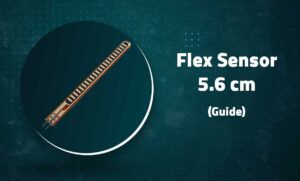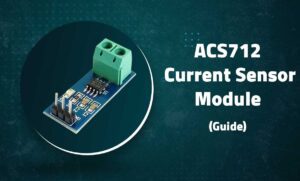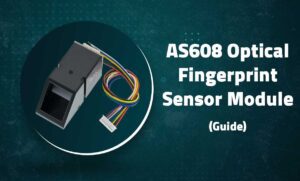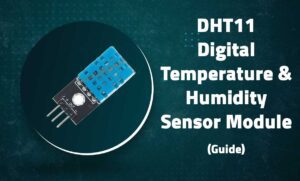Waterproof Ultrasonic Obstacle Sensor, Sensor with Separate Probe
+
Waterproof Ultrasonic Obstacle Sensor
Distance Measurement with Separate Waterproof Probe
Introduction
The Waterproof Ultrasonic Sensor features a separate waterproof probe connected to a control board, making it ideal for outdoor or wet environment applications. Using ultrasonic waves, it accurately measures distances from 2cm to 4.5m with a resolution of 0.3cm, even in challenging conditions.
 Key Features
Key Features
Waterproof Design
IP67 rated probe for wet environments
Accurate Measurement
2cm-450cm range with 3mm resolution
Dual Output
Analog voltage and digital PWM signals
Easy Integration
Works with 3.3V or 5V systems
Technical Specifications
| Operating Voltage | 3.3V – 5V DC |
|---|---|
| Measurement Range | 2cm – 450cm |
| Resolution | 0.3cm |
| Frequency | 40kHz |
| Output Signals | Analog voltage (0-VCC) and PWM |
| Probe Protection | IP67 waterproof rating |
| Operating Temperature | -10°C to +70°C |
| Cable Length | 1m (standard, customizable) |
Pin Configuration

| Pin | Label | Description | Arduino Connection |
|---|---|---|---|
| 1 | VCC | Power (3.3V-5V) | 5V |
| 2 | GND | Ground | GND |
| 3 | OUT | Analog output (0-VCC) | A0 |
| 4 | PWM | Digital PWM output | D2 |
| 5 | TRIG | Trigger input (optional) | D3 |
Note: The waterproof probe should be mounted with the sensing surface free of obstructions
Wiring with Arduino
// Basic Connections: // VCC → 5V // GND → GND // OUT → A0 (analog input) // PWM → D2 (digital input) // Optional trigger: // TRIG → D3 (digital output) // Keep the control board in a dry location // Only the waterproof probe should be exposed
Important: While the probe is waterproof, the control board should be protected from moisture
Basic Distance Measurement Example
// Waterproof Ultrasonic Sensor Basic Example
const int analogPin = A0;
const int pwmPin = 2;
void setup() {
Serial.begin(9600);
pinMode(pwmPin, INPUT);
}
void loop() {
// Read analog output (0-VCC corresponds to 0-max distance)
int analogValue = analogRead(analogPin);
float analogDistance = map(analogValue, 0, 1023, 0, 450); // cm
// Read PWM pulse width (pulse duration in μs corresponds to distance)
float pulseWidth = pulseIn(pwmPin, HIGH);
float pwmDistance = pulseWidth / 58.0; // Convert to cm
Serial.print("Analog Distance: ");
Serial.print(analogDistance);
Serial.print(" cm | PWM Distance: ");
Serial.print(pwmDistance);
Serial.println(" cm");
delay(200);
}
Advanced Features
Trigger Mode
// Manual trigger control
void triggerMeasurement() {
digitalWrite(TRIG_PIN, HIGH);
delayMicroseconds(10);
digitalWrite(TRIG_PIN, LOW);
}
// More precise timing control than automatic modeMultiple Sensors
// Manage multiple sensors with trigger pins
void readSensors() {
triggerSensor1();
delay(50); // Allow time for measurement
float dist1 = readDistance(SENSOR1_PIN);
triggerSensor2();
delay(50);
float dist2 = readDistance(SENSOR2_PIN);
}Moving Average
// Smooth readings with moving average
const int numReadings = 5;
float readings[numReadings];
int index = 0;
float smoothDistance(float newDistance) {
readings[index] = newDistance;
index = (index + 1) % numReadings;
float total = 0;
for (int i = 0; i < numReadings; i++) {
total += readings[i];
}
return total / numReadings;
}Obstacle Detection
// Detect obstacles within threshold
bool checkObstacle(float threshold) {
float distance = readDistance();
return distance < threshold;
}
void loop() {
if (checkObstacle(30.0)) { // 30cm threshold
activateAlarm();
}
}Troubleshooting
No Measurements
- Check power supply (3.3V-5V)
- Verify all connections
- Ensure probe is not obstructed
Inconsistent Readings
- Clean probe surface from debris
- Ensure stable mounting
- Implement software smoothing
Short Range Only
- Check for sound-absorbing materials
- Verify power supply is adequate
- Test in different environmental conditions
Related Posts
MG90S Mini Digital 180° Servo
MG90S Mini Digital 180° Servo
Metal Gear, 2.2kg·cm Torque for RC and Robotics
Introduction
The MG90S is a compact di...
XKC-Y25-V Non-Contact Water Liquid Level Sensor
XKC-Y25-V Non-Contact Water Liquid Level Sensor
Capacitive Detection Without Physical Contact
Introduction
The XKC-Y...
Water Level Depth Detection Sensor
Water Level Depth Detection Sensor
Liquid Measurement for Arduino and IoT Projects
Introduction
The Water Level Dept...
VL53L0X Purple Laser Distance Sensor Module
VL53L0X Laser Distance Sensor Module
High-Speed, High-Precision Time-of-Flight Distance Measurement
Introduction
The...
TCS34725 RGB Color Sensor Module
TCS34725 RGB Color Sensor Module
High-Accuracy Digital Color Detection with IR Filter
Introduction
The TCS34725 is a...
TCS3200 Color Sensor Module
TCS3200 Color Sensor Module
Precise RGB Color Detection for Arduino and Embedded Projects
Introduction
The TCS3200 C...
PN532 NFC RFID Read/Write Module V3 Kit
PN532 NFC RFID Read/Write Module V3 Kit
Advanced Near Field Communication for Arduino and Embedded Systems
Introducti...
HC-SR501 PIR Motion Sensor Module
HC-SR501 PIR Motion Sensor Module
Passive Infrared Detection for Security and Automation Projects
Introduction
The H...
Flex Sensor 5.6 cm (Detect Bending Motion)
Flex Sensor 5.6cm
Bend Detection Sensor for Arduino and Wearable Electronics Projects
Introduction
The 5.6cm...
ACS712 Current Sensor Module
ACS712 5A Current Sensor Module
Hall-Effect Based AC/DC Current Measurement for Arduino Projects
Introduction
The AC...
AS608 Optical Fingerprint Sensor Module
AS608 Optical Fingerprint Sensor Module
High-Precision Biometric Recognition for Arduino and Microcontroller Projects
...
DHT11 Temperature and Humidity Sensor Module
DHT11 Temperature & Humidity Sensor
Basic Environmental Sensing with Status LED for Arduino Projects
Introduction...







Recent Comments